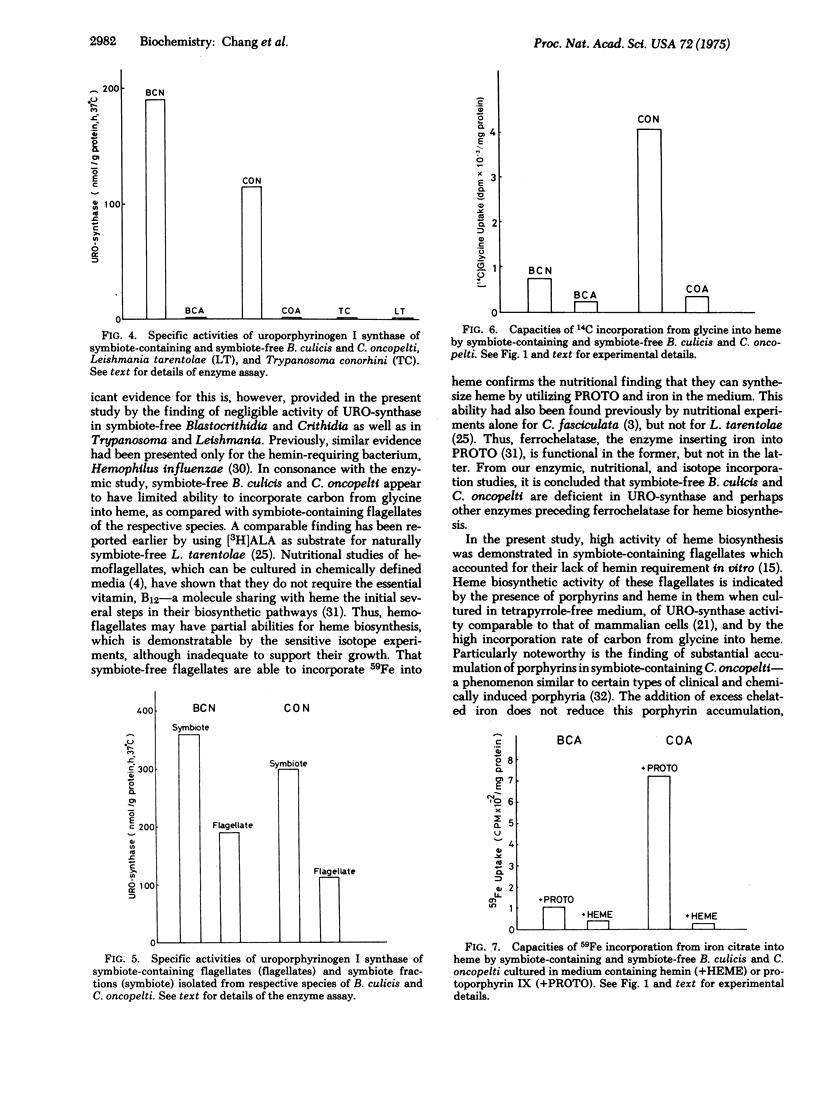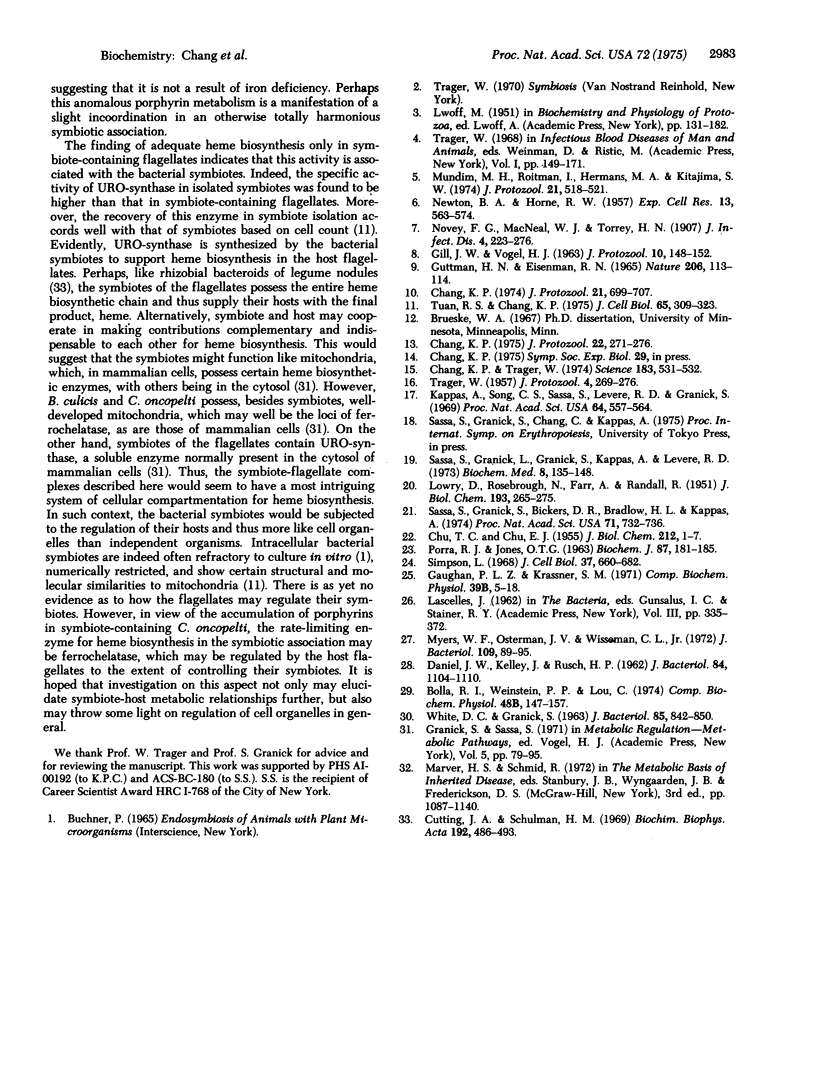Abstract
Heme biosynthetic activity in the symbiotic association involving crithidial flagellates and intracellular bacteroids was studied by enzymic, nutritional, and isotope incorporation experiments. Component organisms and their complexes in this association were analyzed separately to determine the underlying cause of the hemin requirement of hemoflagellates and the role of symbiotes in sparing this requirement of two crithidial species. Nutritional study of symbiote-free flagellates showed that their growth requires at least 0.1 mug/ml of hemin, which can be substituted by protoporphyrin IX, but not by the porphyrin precursors, delta-amino-levulinic acid or porphobilinogen. These flagellates, in the presence of protoporphyrin IX, incorporated 59Fe into heme, indicating that they possess ferrochelatase (EC 4.99.1.1), the terminal enzyme in the heme biosynthetic pathway, which catalyzes the insertion of iron into protoporphyrin IX. In symbiote-containing flagellates serially cultured in a defined medium free of tetrapyrrole compounds, heme and porphyrins can be detected by a fluorophotometric method, indicative of heme biosynthesis. Study of [14C]glycine incorporation into heme showed that the rate is much higher in symbiote-containing flagellates than in those without symbiotes. Microassay of uroporphyrinogen I synthase [EC 4.3.1.8; porphobilinogen ammonia-lyase (polymerizing)] revealed that the specific activity is high in symbiote-containing flagellates and higher still in isolated symbiotes, but essentially negligible in symbiote-free organisms. It is concluded that the bacterial symbiotes augment a very limited heme biosynthetic capacity of host flagellates by supplying uroporphyrinogen I synthase and perhaps other enzymes preceding ferrochelatase in the heme biosynthetic chain.
Full text
PDF




Selected References
These references are in PubMed. This may not be the complete list of references from this article.
- Bolla R. I., Weinstein P. P., Lou C. In vitro nutritional requirements of Nippostrongylus brasiliensis. II. Effects of heme compounds, porphyrins and bile pigments on the free-living stages. Comp Biochem Physiol B. 1974 May 15;48(1):147–157. doi: 10.1016/0305-0491(74)90049-2. [DOI] [PubMed] [Google Scholar]
- CHU T. C., CHU E. J. H. Paper chromatography of iron complexes of porphyrins. J Biol Chem. 1955 Jan;212(1):1–7. [PubMed] [Google Scholar]
- Chang K. P. Reduced growth of Blastocrithidia culicis and Crithidia oncopelti freed of intracellular symbiotes by chloramphenicol. J Protozool. 1975 May;22(2):271–276. doi: 10.1111/j.1550-7408.1975.tb05866.x. [DOI] [PubMed] [Google Scholar]
- Chang K. P., Trager W. Nutritional significance of symbiotic bacteria in two species of hemoflagellates. Science. 1974 Feb 8;183(4124):531–532. doi: 10.1126/science.183.4124.531. [DOI] [PubMed] [Google Scholar]
- Chang K. P. Ultrastructure of symbiotic bacteria in normal and antibiotic-treated Blastocrithidia culicis and Crithidia oncopelti. J Protozool. 1974 Nov;21(5):699–707. doi: 10.1111/j.1550-7408.1974.tb03733.x. [DOI] [PubMed] [Google Scholar]
- Cutting J. A., Schulman H. M. The site of heme synthesis in soybean root nodules. Biochim Biophys Acta. 1969 Dec 30;192(3):486–493. doi: 10.1016/0304-4165(69)90398-5. [DOI] [PubMed] [Google Scholar]
- DANIEL J. W., KELLEY J., RUSCH H. P. Hematin--requiring plasmodial myxomycete. J Bacteriol. 1962 Nov;84:1104–1110. doi: 10.1128/jb.84.5.1104-1110.1962. [DOI] [PMC free article] [PubMed] [Google Scholar]
- GUTTMAN H. N., EISENMAN R. N. 'CURE' OF CRITHIDIA (STRIGOMONAS) ONCOPELTI OF ITS BACTERIAL ENDOSYMBIOTE. Nature. 1965 Apr 3;206:113–114. doi: 10.1038/206113a0. [DOI] [PubMed] [Google Scholar]
- Kappas A., Song C. S., Sassa S., Levere R. D., Granick S. The occurrence of substances in human plasma capable of inducing the enzyme delta-aminolevulinate synthetase in liver cells. Proc Natl Acad Sci U S A. 1969 Oct;64(2):557–564. doi: 10.1073/pnas.64.2.557. [DOI] [PMC free article] [PubMed] [Google Scholar]
- LOWRY O. H., ROSEBROUGH N. J., FARR A. L., RANDALL R. J. Protein measurement with the Folin phenol reagent. J Biol Chem. 1951 Nov;193(1):265–275. [PubMed] [Google Scholar]
- Mundim M. H., Roitman I., Hermans M. A., Kitajima E. W. Simple nutrition of Crithidia deanei, a reduviid trypanosomatid with an endosymbiont. J Protozool. 1974 Oct;21(4):518–521. doi: 10.1111/j.1550-7408.1974.tb03691.x. [DOI] [PubMed] [Google Scholar]
- Myers W. F., Osterman J. V., Wisseman C. L., Jr Nutritional studies of Rickettsia guintana: nature of the hematin requirement. J Bacteriol. 1972 Jan;109(1):89–95. doi: 10.1128/jb.109.1.89-95.1972. [DOI] [PMC free article] [PubMed] [Google Scholar]
- NEWTON B. A., HORNE R. W. Intracellular structures in Strigomonas oncopelti. I. Cytoplasmic structures containing ribonucleoprotein. Exp Cell Res. 1957 Dec;13(3):563–574. doi: 10.1016/0014-4827(57)90086-1. [DOI] [PubMed] [Google Scholar]
- PORRA R. J., JONES O. T. Studies on ferrochelatase. 1. Assay and properties of ferrochelatase from a pig-liver mitochondrial extract. Biochem J. 1963 Apr;87:181–185. doi: 10.1042/bj0870181. [DOI] [PMC free article] [PubMed] [Google Scholar]
- Sassa S., Granick J. L., Granick S., Kappas A., Levere R. D. Studies in lead poisoning. I. Microanalysis of erythrocyte protoporphyrin levels by spectrophotometry in the detection of chronic lead intoxication in the subclinical range. Biochem Med. 1973 Aug;8(1):135–148. doi: 10.1016/0006-2944(73)90017-3. [DOI] [PubMed] [Google Scholar]
- Sassa S., Granick S., Bickers D. R., Bradlow H. L., Kappas A. A microassay for uroporphyrinogen I synthase, one of three abnormal enzyme activities in acute intermittent porphyria, and its application to the study of the genetics of this disease. Proc Natl Acad Sci U S A. 1974 Mar;71(3):732–736. doi: 10.1073/pnas.71.3.732. [DOI] [PMC free article] [PubMed] [Google Scholar]
- Simpson L. Effect of acriflavin on the kinetoplast of Leishmania tarentolae. Mode of action and physiological correlates of the loss of kinetoplast DNA. J Cell Biol. 1968 Jun;37(3):660–682. doi: 10.1083/jcb.37.3.660. [DOI] [PMC free article] [PubMed] [Google Scholar]
- Tuan R. S., Chang K. P. Isolation of intracellular symbiotes by immune lysis of flagellate protozoa and characterization of their DNA. J Cell Biol. 1975 May;65(2):309–323. doi: 10.1083/jcb.65.2.309. [DOI] [PMC free article] [PubMed] [Google Scholar]
- WHITE D. C., GRANICK S. HEMIN BIOSYNTHESIS IN HAEMOPHILUS. J Bacteriol. 1963 Apr;85:842–850. doi: 10.1128/jb.85.4.842-850.1963. [DOI] [PMC free article] [PubMed] [Google Scholar]


